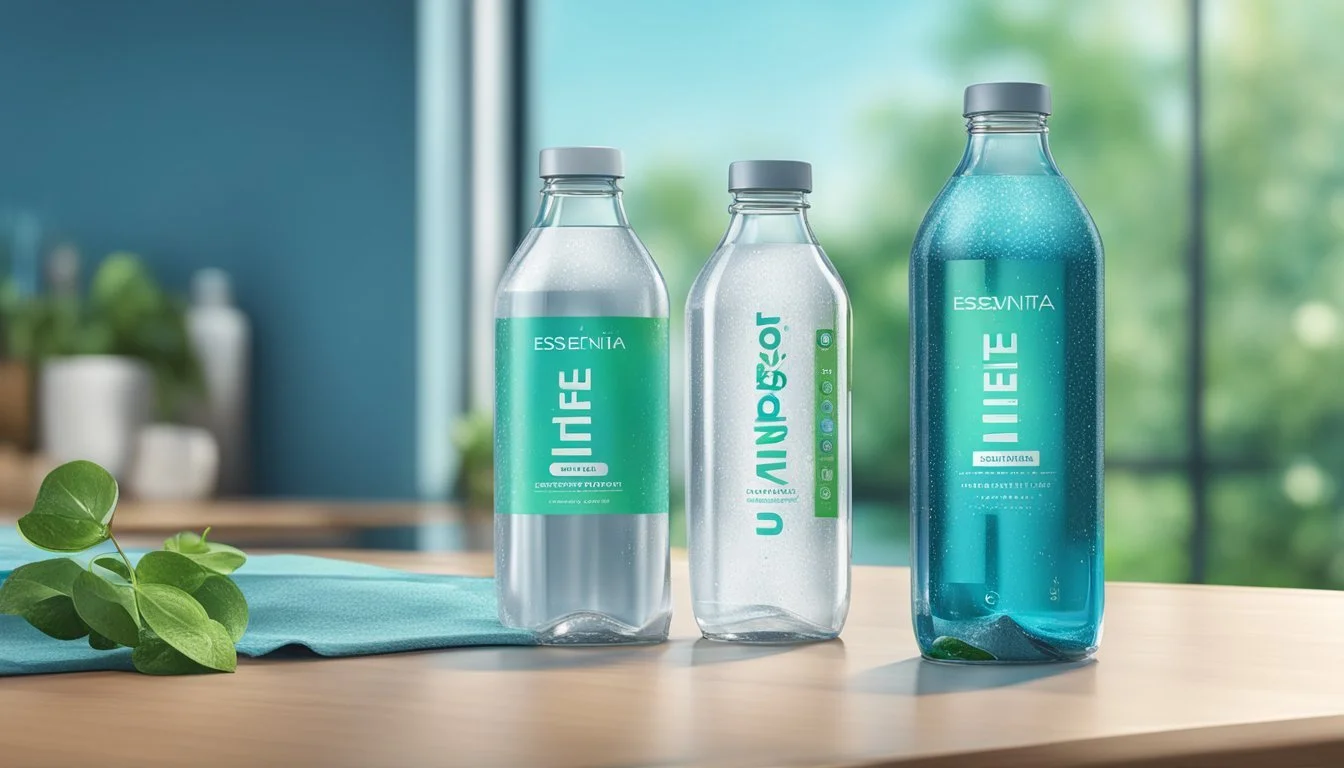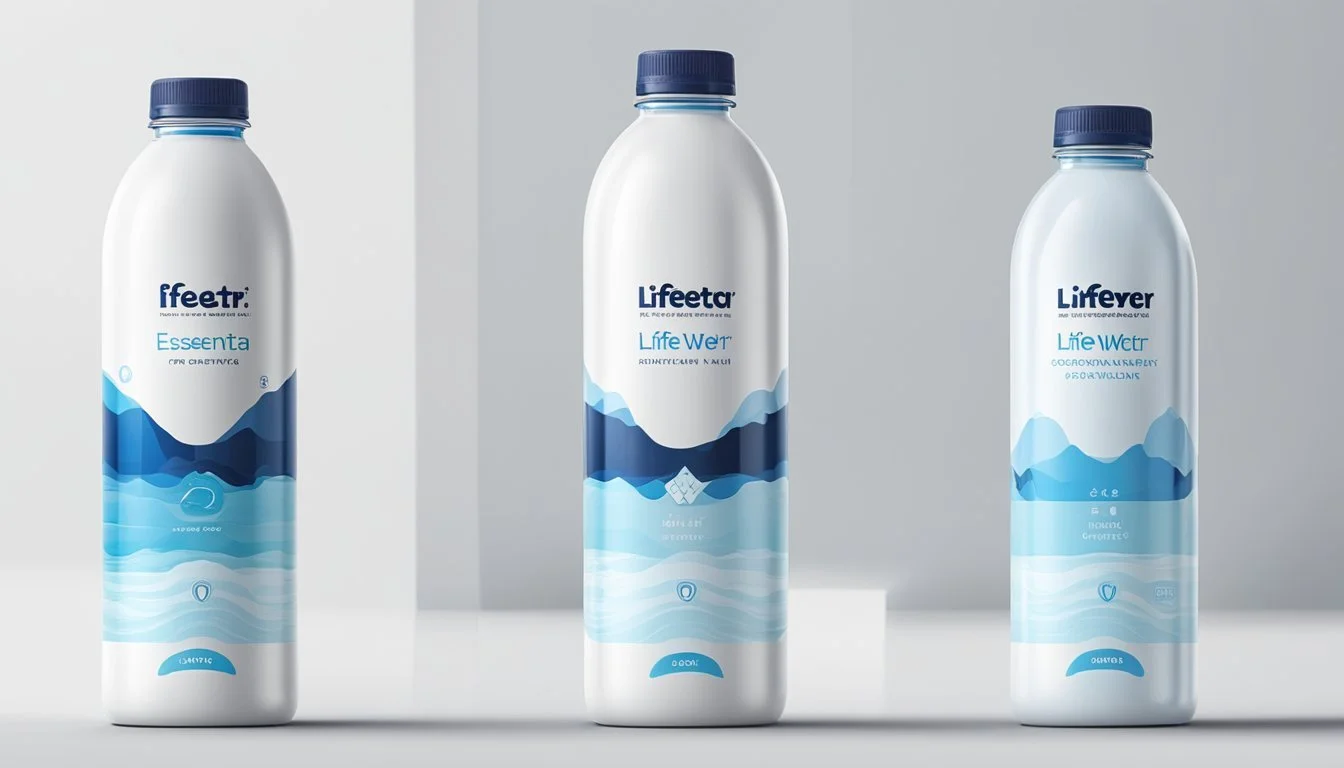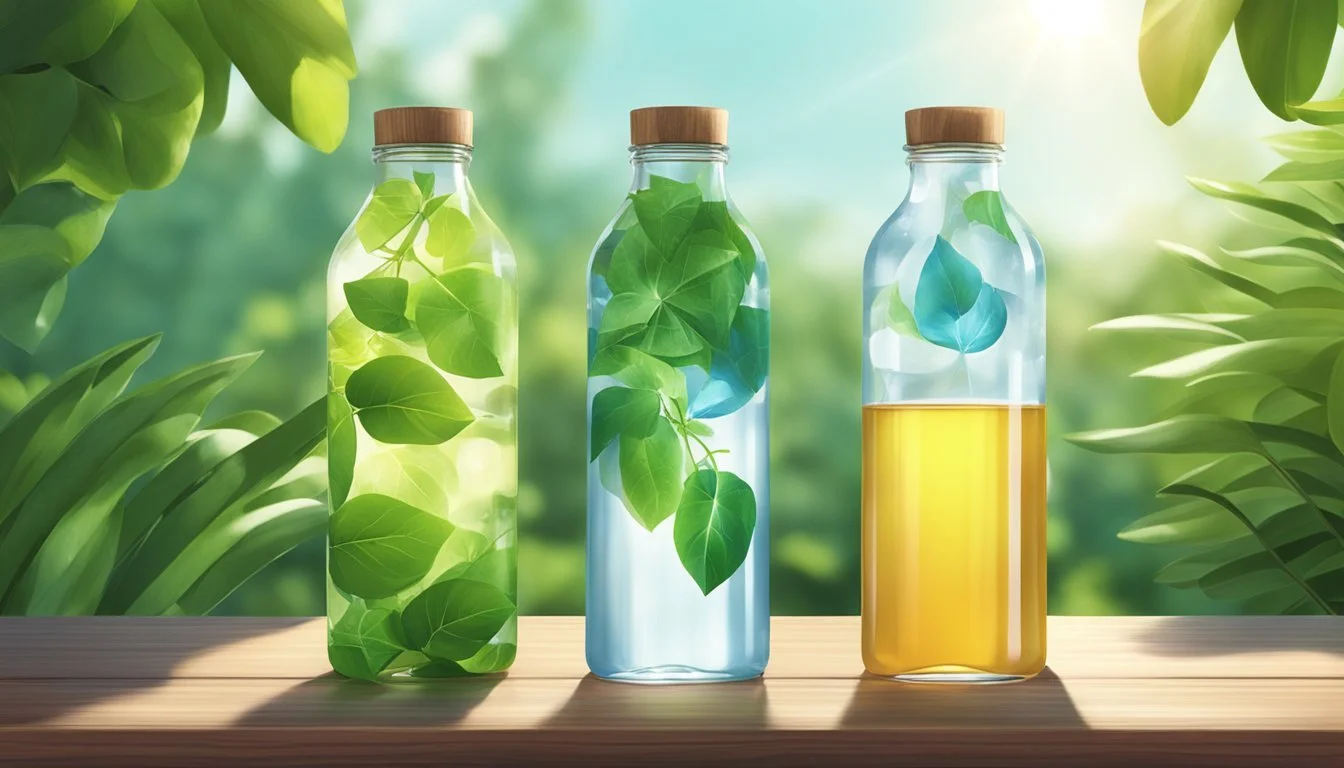Essentia vs. LIFEWTR
A Comparative Analysis of Bottled Water Brands
In the world of bottled water, consumers are often faced with an overwhelming variety of options, each touting unique benefits and qualities. Among the multitude of brands, Essentia and LIFEWTR emerge as popular choices for those seeking more than just hydration. Essentia is known for its high pH level of 9.5, making it an alkaline water, which proponents suggest can offer hydration with a difference. The brand achieves this through a process that includes microfiltration and reverse osmosis, followed by the addition of electrolytes.
LIFEWTR, on the other hand, positions itself as a premium water brand that also delivers hydration with a unique composition. While less is said about its pH level, the brand focuses on the artistic design of its bottles and the purity of its water. Both brands differ in their approach to capturing the market's interest, and yet, they simultaneously compete in the space of enhanced bottled water options that promise a superior drinking experience.
The choice between Essentia and LIFEWTR may come down to personal preference or particular qualities that a consumer values in their bottled water. Whether it's the alkaline nature and electrolyte infusion of Essentia or the artistic branding and taste profile of LIFEWTR, each brand offers a distinct proposition. In this article, their differences are explored to help readers determine which bottled water might be the better option for their personal needs.
Understanding Bottled Water
In the context of comparing Essentia and LIFEWTR, clarity about water sources, types, and regulatory standards is crucial for an informed choice.
Water Sources
Bottled water companies often source water from various locations, including natural springs, aquifers, and municipal water supplies. Spring water and mineral water are derived from underground formations where water flows naturally to the earth's surface. Essentia and LIFEWTR, for example, may collect their water from protected wells or springs, ensuring a natural water source.
Types of Bottled Water
Bottled water comes in several varieties:
Spring Water: Collected directly from a spring where water naturally comes to the surface.
Mineral Water: Contains naturally occurring minerals and trace elements.
Purified Water: Processed to remove chemicals and contaminants. Methods include distillation, deionization, or reverse osmosis.
Alkaline Water: Has a higher pH level than regular drinking water, often around 9.5, as with Essentia Water.
Sparkling Water: Contains dissolved carbon dioxide gas, either naturally occurring or added during bottling.
Distilled Water: Vaporized and then condensed back into liquid, removing impurities and minerals.
The distinction between these types can affect both taste and health benefits.
Regulatory Standards
In the United States, bottled water is regulated by the Environmental Protection Agency (EPA). The EPA ensures that all types of bottled water, including spring, mineral, and purified, meet strict safety standards before they are allowed on store shelves. Standards include limits on contaminants and requirements for proper labeling. The U.S. Pharmacopeia also cites standards for particular types, like purified water, setting benchmarks for sterility and quality.
The Bottled Water Industry
The bottled water industry is defined by its vast selection of brands and the environmental discussions surrounding the production and disposal of plastic bottles. Leading companies like Coca-Cola and PepsiCo have significant market shares and focus on delivering a variety of water products to cater to consumer preferences.
Market Overview
The market for bottled water has seen exponential growth, with Coca-Cola and PepsiCo being key players through their respective water brands. Coca-Cola offers a diverse range of bottled water including environmentally conscious options such as LIFEWTR, which is marketed as a premium water brand that is pH-balanced with added electrolytes. On the other side, PepsiCo also presents competition with its brand LIFEWTR, aspiring to attract consumers who value pH-balanced water with a focus on creativity and artistry in packaging.
Nestlé Waters joins these behemoths, standing as one of the world's largest bottled water companies, although it often faces criticism for its environmental impact and the sources of its water.
Brand Owner Notable Features LIFEWTR PepsiCo pH balanced, Artistic Design Essentia Essentia Water LLC Ionized, pH balanced Nestlé Pure Life Nestlé Waters Globally Distributed
Most bottled water brands, including Essentia and LIFEWTR, emphasize their BPA-free packaging, aligning with consumer demand for health-safe products.
Environmental Concerns
The industry is not without its criticisms, particularly regarding the use of plastic bottles. Environmentalists argue that the production and disposal of plastic contribute to pollution and use of non-renewable resources. Both Coca-Cola and PepsiCo acknowledge these concerns and are working towards more sustainable packaging solutions. For example, LIFEWTR bottles are made with 100% rPET (recycled polyethylene terephthalate), aimed at reducing the carbon footprint and reliance on new plastics.
The push for environmental responsibility has influenced many brands to explore alternatives and invest in recycling initiatives, fostering a more sustainable future for the bottled water industry.
Essentia vs. LIFEWTR Comparison
In the battle of bottled waters, two brands stand out for their high pH and added electrolytes: Essentia and LIFEWTR. This comparison will explore the brand identities and vital product characteristics to help consumers understand their options.
Brand Profiles
Essentia markets itself as a leader in ionized alkaline water. It boasts a 9.5 pH level, which is among the highest available for bottled water. Its purification process includes microfiltration, reverse osmosis, and the infusion of electrolytes. Essentia is often praised for its taste and the brand claims that the higher pH level can better hydrate the body.
Purification process: Microfiltration and reverse osmosis
pH level: 9.5
Added electrolytes: Yes
LIFEWTR is a premium brand that emphasizes art and design on its bottles, with a dedication to hydration and pH balance. The brand provides a pH balanced to fit within the human body's natural range, using purified water infused with electrolytes for taste.
Purification process: Purification unknown from data
pH level: Balanced
Added electrolytes: Yes
Both brands set themselves apart from other options such as Dasani and Aquafina, which are known for their purification methods but don't highlight alkalinity or pH balance as selling points. Unlike Nestle Pure Life, which focuses on affordability, or Evian and Fiji Water, which are known for their source waters, Essentia and LIFEWTR offer unique propositions around functionality and added benefits. Smartwater also comes into play, offering electrolytes but with a vapor-distilled process and a focus on a clean, crisp taste.
Hydration and Health
In the comparison of Essentia Water and LIFEWTR, it is critical to understand how hydration and pH balance play a key role in one’s overall health and wellness.
Hydration Benefits
Proper hydration is essential for maintaining bodily functions and overall health benefits. It impacts various bodily systems, aiding in nutrient transport, waste removal, and temperature regulation. Better hydration supports cognitive function and physical performance. Both Essentia and LIFEWTR provide the necessary hydration that the body requires, but their approaches and added benefits differ, particularly concerning pH levels.
Nutrient Transport: Hydration assists in transporting essential nutrients to cells.
Waste Removal: It facilitates the removal of waste products from the body.
Temperature Regulation: Adequate fluid intake helps maintain normal body temperature.
pH and Body Balance
The pH level of water can influence the body’s pH balance. Essentia Water is known for its high-pH, created through ionization, making it alkaline water. Alkaline water has a pH level above 7, with Essentia often touting a level of 9.5 or higher. The proponents of alkaline water claim it can help neutralize stomach acid, which might be beneficial for those experiencing acid reflux. LIFEWTR, classified as purified water, maintains a pH level that is close to neutral. While the health impact of alkaline water on pH balance is subject to ongoing research, it is crucial to note that the body generally maintains pH equilibrium through homeostasis.
Essentia Water: High-alkaline water with a pH of 9.5 or higher.
LIFEWTR: pH-balanced to match a neutral level.
In both cases, the products offer hydration which is fundamental for health, and any effects related to pH are supplementary.
Water Quality and Composition
Determining the quality of bottled water involves analyzing pH levels, the presence of electrolytes and minerals, and the overall purity reflected by the total dissolved solids count.
Testing and pH Levels
Essentia water boasts a high pH level, typically over 9.5, making it one of the more alkaline options on the market. LIFEWTR also provides a slightly alkaline pH, which is in the range of 6.4 to 7.4, however, their focus is more on the artful packaging and the purified water rather than the pH levels. Both brands claim their water is purified via reverse osmosis, effectively reducing the total dissolved solids (TDS) to nearly negligible levels, ensuring purity.
Electrolytes and Minerals
Both Essentia and LIFEWTR enhance their water with various electrolytes for taste, although the specific formulas differ:
Essentia incorporates electrolytes like sodium bicarbonate, dipotassium phosphate, magnesium sulfate, and calcium chloride for ionization purposes.
LIFEWTR adds electrolytes such as potassium bicarbonate and magnesium sulfate, primarily for flavor enhancement.
Often consumers choose bottled water not just for hydration but also for the additional minerals and nutrients. Essentia and LIFEWTR both contain valuable minerals such as calcium, potassium, and magnesium, contributing to the nutritional profile of the water. However, the exact quantities of these minerals are proprietary to each brand.
Purification and Filtration Processes
When evaluating bottled water brands like Essentia and LIFEWTR, understanding their purification and filtration processes is critical. These processes ensure water quality and define the taste and health benefits of the final product.
Reverse Osmosis and Distillation
Essentia utilizes reverse osmosis to remove impurities and ionization to raise pH levels. Reverse osmosis is a filtration method that forces water through a semi-permeable membrane, removing contaminants such as heavy metals and bacteria. LIFEWTR, as indicated in the provided snippet, also uses reverse osmosis to purify its water before enhancement with minerals.
Microfiltration and Ionization
Microfiltration is another stage in the purification process, where water is passed through a filter with small pores to remove suspended particles. In conjunction with reverse osmosis, it ensures a high level of purity. Ionization, which is used by Essentia, alters the water to produce ionized alkaline water. This process can also affect the taste and perceived "smoothness" of the water.
Essentia's Proprietary Process
Essentia touts its unique process called Hydro-7™, designed to filter the water and then ionize it. This proprietary process claims to enhance Essentia water with electrolytes for taste, ultimately providing a product that supports better hydration, often marketed as ionized alkaline water.
LIFEWTR's Purification
LIFEWTR emphasizes its focus on art and design, but the brand also places a strong emphasis on the purification process. After reverse osmosis, LIFEWTR infuses the water with electrolytes, which does not only improve taste but also contributes to the overall mineral content of the water, providing what they describe as optimal hydration.
Taste and Water Preference
When discerning between Essentia and LIFEWTR, consumers primarily focus on the flavor profile, individual taste preferences, and the relationship between taste and water purity.
Flavor Profile Analysis
Essentia boasts a high pH level of 9.5, indicative of alkaline water, which may contribute to its taste being described as smooth and clean. A rigorous purification process including microfiltration and reverse osmosis is employed, with the final product enhanced by added electrolytes for taste.
LIFEWTR, on the other hand, is known for its crispness and overall good taste. It doesn't possess the same high pH level as Essentia but is remarked upon for its freshness, possibly attributable to its inclusion of electrolytes and minerals purported to improve taste.
Consumer Taste Preferences
Preferences among consumers vary widely, but there are discernible patterns:
Some gravitate towards Essentia for its lack of bitterness and acidic taste.
LIFEWTR's fans may appreciate its sharp, clean profile, potentially ranking it higher than other water brands that might offer a perceived flat or bland taste.
Popularity does not always equate with a preference for a "better" taste, as individual palettes differ greatly. Brand experiences and marketing can also shape consumer expectations and perceptions of taste.
Taste vs. Purity
When comparing Essentia and LIFEWTR, it is vital to understand that while taste is a significant factor for consumers, it is inherently linked to the purity of the water. Both brands claim to provide clean drinking water:
Essentia emphasizes its high pH and added electrolytes, suggesting a correlation between the purification process and a favorable taste profile.
LIFEWTR suggests that the clarity of its water, achieved through its filtration process, directly influences its refreshing taste.
The debate over which water is the best is subjective and can fluctuate on a spectrum from "worst" to "best" based on individual taste and the value placed on the purity and cleanliness of the water.
Additional Considerations
When comparing Essentia and LIFEWTR, it's crucial to consider the various aspects beyond just taste and hydration. Packaging, lifestyle compatibility, and the comparison to tap water and other alternatives are all important factors that may sway a consumer's preference.
Labeling and Packaging
Essentia bottles feature BPA-free plastic, ensuring a reduction in potential chemical leaching. They prioritize an alkaline water product with a pH of 9.5, clearly labeled for those seeking higher pH levels. LIFEWTR, on the other hand, showcases a distinct approach to branding by highlighting artists on its labels, aiming to appeal to consumers who appreciate art and design in their lifestyle.
Convenience and Lifestyle
Both Essentia and LIFEWTR are available in many stores, including Starbucks, offering convenience to consumers. Essentia markets itself toward those who lead active lifestyles and might already be consumers of products like Gatorade. LIFEWTR aligns itself with creativity and might attract those interested in cultural elements, similar to how brands like San Pellegrino have positioned themselves with fine dining.
Comparison to Tap and Alternatives
A primary factor is how these brands stack up against tap water and other bottled waters. Essentia and LIFEWTR are both marketed as premium alternatives to conventional bottled waters, such as Nestlé Pure Life. They sit alongside counterparts such as Fiji Water and Evian in a crowded market that includes options from sparkling to alkaline waters. While more expensive than tap water, these brands offer a different experience that may align better with the values and taste preferences of certain consumers.
Conclusion
When comparing Essentia and LIFEWTR, consumers are faced with two reputable brands in the bottled water market. Essentia touts itself with a pH level of 9.5 and claims to offer purified water with health benefits associated with alkaline water. This potentially caters to those seeking a water with minimal acidity and an 'exceptionally clean' taste.
LIFEWTR, on the other hand, positions itself as a crisp option that meets the expectations of a purified water without necessarily exceeding beyond the standard offerings of other competitors in the market. It stands as a middle-of-the-pack choice that provides a refreshing experience but does not differentiate itself significantly on the basis of health benefits.
Both brands underscore the importance of a safe and pleasant drinking experience, yet neither should be considered a singular solution for health; a balanced diet and lifestyle are essential to wellbeing. Consumers choosing between Essentia and LIFEWTR should consider their personal preferences for taste and pH balance, as well as the environmental impact of bottled water.
Aspect Essentia LIFEWTR Water Type Alkaline Water Purified Water pH Level 9.5 Standard pH Claimed Benefits High pH, low acidity Safe, crisp water Differentiators Exceptionally clean taste Middle-of-the-pack offering
Ultimately, the choice between Essentia and LIFEWTR comes down to personal preference and priorities, whether they lie in taste, pH level, or other factors.








